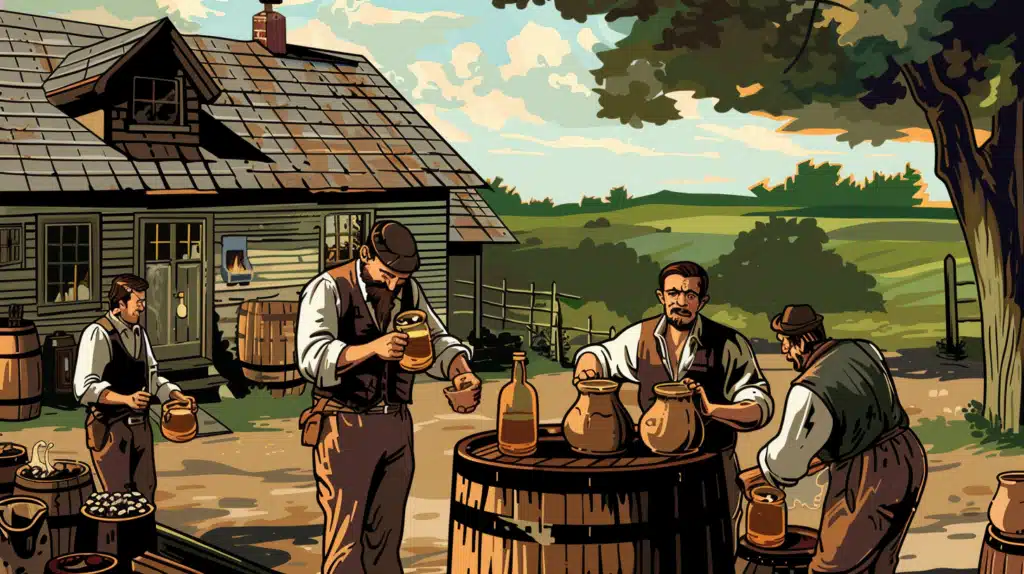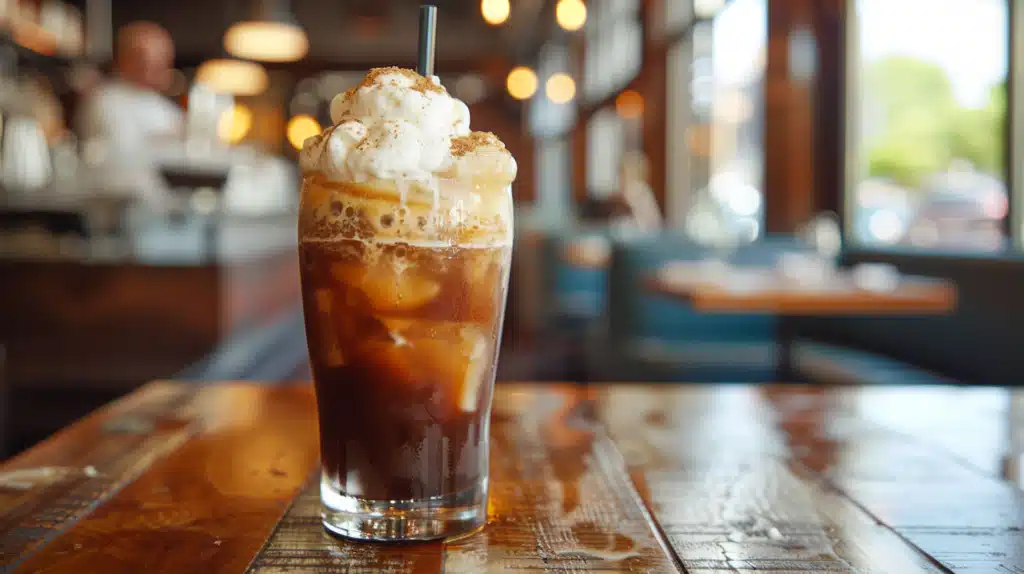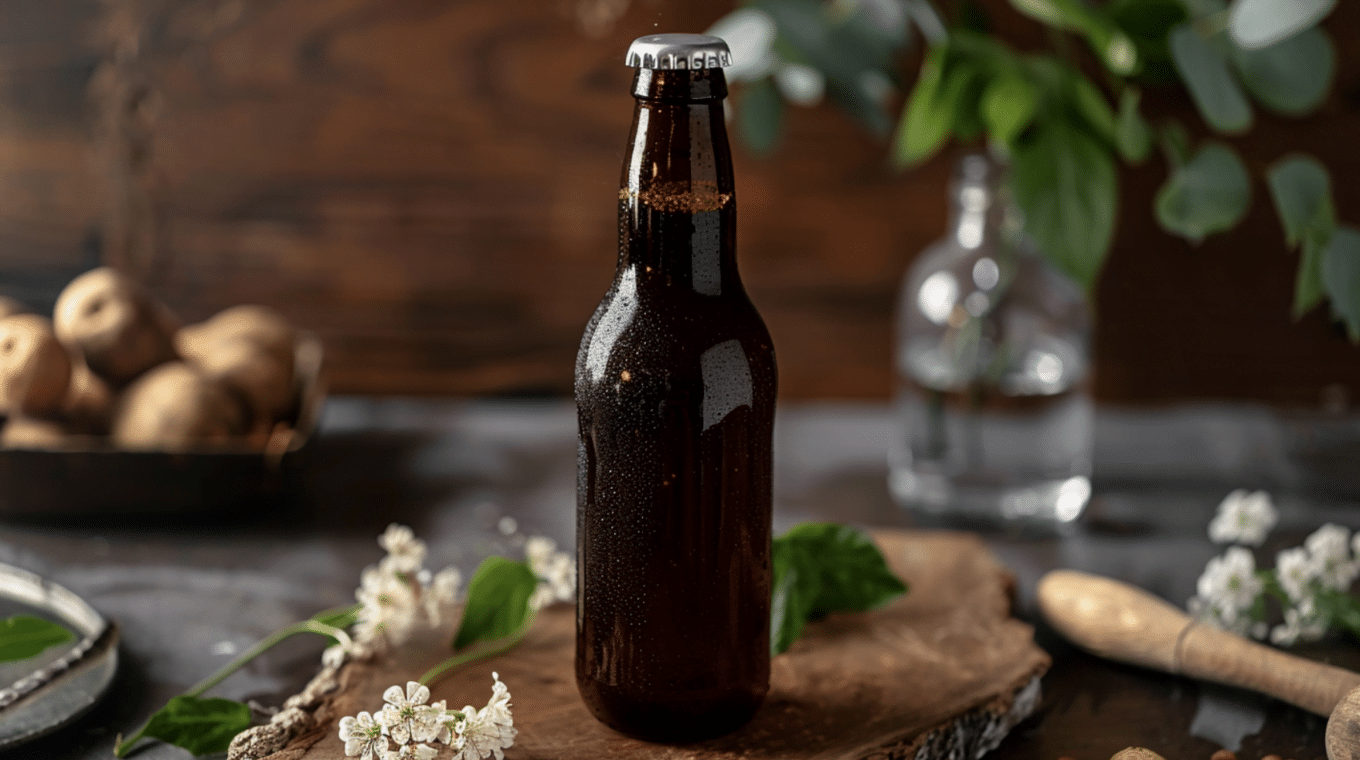Are you tired of the same old sugary sodas loaded with caffeine? Do you crave a refreshing beverage that won’t leave you jittery or disrupt your sleep?
Look no further than caffeine-free root beer! This delightful drink offers the classic, creamy flavor you love without the unwanted buzz.
Imagine sipping on a frosty mug of root beer, enjoying its smooth taste and subtle hints of vanilla and sassafras.
The best part? You can indulge in this treat guilt-free at any time of day. Say goodbye to the midday crash and hello to a satisfying, caffeine-free alternative.
Join us as we explore the world of caffeine-free root beer and discover why it’s the perfect choice for soda lovers seeking a refreshing change.
What is Root Beer?

Root beer has been a beloved beverage in America for centuries, with a rich history and evolving production methods.
Let’s explore the background of this classic drink and the differences between traditional and modern variations.
Historical Background
Root beer traces back to the colonial era when settlers crafted beverages using local herbs, bark, and roots.
One of the key ingredients was sassafras, which imparted a distinct flavor to the brew. These homemade concoctions were enjoyed as refreshing and medicinal drinks, believed to have various health benefits.
Traditional Methods
Early root beer production relied heavily on natural ingredients sourced from local flora. Recipes varied based on regional availability, but common components included:
- Sassafras root bark
- Vanilla bean
- Wintergreen
- Licorice root
- Cinnamon
- Nutmeg
These ingredients were boiled together to create a concentrated syrup, which was then mixed with carbonated water to produce the final beverage.
Modern Variations
As root beer gained popularity, commercial production began in the late 19th century. However, with mass production came changes in recipes and ingredient sourcing.
Many modern root beers now include:
- Artificial sassafras flavoring (due to safrole content in natural sassafras)
- High fructose corn syrup as a sweetener
- Preservatives for longer shelf life
- Caffeine (in some brands) to appeal to broader consumer preferences
Key Differences- Traditional vs. Modern Root Beer
While both traditional and modern root beers aim to capture the classic flavor profile, there are notable differences between the two:
| Traditional Root Beer | Modern Root Beer |
|---|---|
| Made with natural ingredients | Often uses artificial flavorings |
| Caffeine-free | Some brands contain caffeine |
| Sweetened with sugar or honey | Frequently sweetened with high fructose corn syrup |
| Small-batch production | Mass-produced for wider distribution |
| Regional variations based on available ingredients | Standardized recipes for consistency |
Despite these differences, the essence of root beer remains the same – a refreshing, flavorful beverage enjoyed by generations.
Whether you prefer a traditional, caffeine-free variety or a modern twist on the classic, there’s a root beer for everyone to savor.
Health Aspects of Caffeine-Free Root Beer

Let’s explore the health benefits of choosing caffeine-free root beer over other beverages.
Benefits of Avoiding Caffeine
- Improved Sleep Quality: One of the primary advantages of caffeine-free root beer is its potential to enhance sleep quality. Consuming caffeine, especially later in the day, can disrupt sleep patterns and lead to insomnia. By choosing a caffeine-free option, you can enjoy your favorite beverage without compromising your rest.
- Reduced Anxiety and Jitters: Caffeine stimulates the nervous system, which can trigger anxiety and jitteriness in some individuals. Caffeine-free root beer avoids these unwanted side effects while savoring the rich, creamy flavor.
- Antioxidant Properties: Traditional root beer ingredients, such as sassafras and sarsaparilla, contain natural compounds with antioxidant properties. These antioxidants help protect your cells from damage caused by harmful free radicals, supporting overall health and well-being.
- Digestive Aid: Some herbs and roots used in traditional root beer recipes have been associated with digestive benefits. For example, licorice root, a common ingredient, has been used to soothe digestive discomfort and support healthy digestion.
Sugar Content and Health Concerns
It’s important to note that while caffeine-free root beer offers several health benefits, it can still contain significant amounts of sugar.
Excessive sugar consumption has been linked to various health concerns, including obesity, diabetes, and dental problems.
To enjoy the benefits of caffeine-free root beer while minimizing potential drawbacks, consider the following:
- Consume in moderation as part of a balanced diet
- Opt for brands with lower sugar content or natural sweeteners
- Look for diet or sugar-free versions if you’re watching your sugar intake
By making informed choices and practicing moderation, you can enjoy the refreshing taste of caffeine-free root beer while supporting your overall health and well-being.
Popular Caffeine-Free Root Beer Brands

When it comes to satisfying your root beer cravings without the buzz of caffeine, several popular brands offer delicious caffeine-free options.
Let’s take a closer look at some of these well-known names.
1. A&W Root Beer
Founded in 1919, A&W has become synonymous with classic root beer flavor. Their caffeine-free version stays true to the original recipe, offering a smooth, creamy taste for all ages. A&W prides itself on using real cane sugar and natural flavors to create an authentic root beer experience.
2. Mug Root Beer
Mug Root Beer, a product of PepsiCo, has been a staple in the soda aisle for decades. Their caffeine-free variety delivers a bold, refreshing flavor that pairs perfectly with ice cream for a classic root beer float. Mug Root Beer is known for its rich, foamy head and subtle vanilla notes.
3. IBC Root Beer
IBC, or Independent Breweries Company, has been crafting root beer since 1919. Their caffeine-free version showcases a commitment to quality ingredients and time-honored brewing techniques. IBC Root Beer features a complex blend of flavors, including sassafras, licorice, and vanilla, resulting in a well-balanced and satisfying taste.
Unique Features Each of these popular caffeine-free root beer brands brings something special to the table:
- A&W’s use of real cane sugar and natural flavors sets it apart as a high-quality, authentic root beer.
- Mug Root Beer’s bold flavor and foamy head make it an ideal choice for root beer floats and other creamy desserts.
- IBC’s dedication to traditional brewing methods and carefully selected ingredients results in a complex, nuanced root beer experience.
Whether you’re a long-time root beer enthusiast or simply looking for a caffeine-free alternative to your usual soda, these popular brands offer a delicious and refreshing option to suit your taste preferences.
Root Beer Alternatives for Caffeine Lovers

While caffeine-free root beer is an excellent choice for those looking to avoid the stimulating effects of caffeine, some individuals may prefer beverages that provide a caffeine kick.
Let’s explore some alternatives that cater to caffeine lovers.
1. Cola
One of the most popular alternatives to root beer is cola. Brands like Coca-Cola and Pepsi offer classic cola flavors that caffeine enthusiasts love. A 12-ounce cola typically contains around 34-38 milligrams of caffeine, providing a moderate energy boost.
Benefits of Cola
- Widely available and easily accessible
- It offers a familiar, satisfying taste
- It provides a quick caffeine fix
Drawbacks of Cola
- High in sugar content, which can lead to health concerns if consumed excessively
- It may not have the same creamy, smooth texture as root beer
- It lacks the unique blend of flavors found in root beer
2. Energy Drinks
For those seeking a more substantial caffeine jolt, energy drinks like Red Bull, Monster, and Rockstar can be appealing alternatives. These beverages often contain higher levels of caffeine, ranging from 80 to over 300 milligrams per can, depending on the brand and serving size.
Benefits of Energy Drinks
- It provides a significant energy boost
- Often available in a variety of flavors
- It may contain additional ingredients like taurine and B vitamins
Drawbacks of Energy Drinks
- High caffeine content can lead to jitters, anxiety, and sleep disruption if consumed in excess.
- Often loaded with sugar and artificial ingredients
- It may not have the same nostalgic appeal as root beer
When considering these alternatives, it’s essential to weigh the benefits and drawbacks of your personal preferences and health goals.
While cola and energy drinks can provide a desired caffeine kick, they may not offer the same unique taste, experience, and charm as root beer.
Ultimately, choosing between caffeine-free root beer and caffeinated alternatives depends on individual taste preferences and caffeine tolerance.
By understanding the options available and their potential effects, you can make an informed decision that aligns with your needs and desires.
How to Check for Caffeine Levels in Root Beer

While most root beer varieties are naturally caffeine-free, some brands may add caffeine to their formulas.
As a responsible consumer, you must know how to check for caffeine levels in your favorite root beer.
Let’s explore labeling practices and provide tips for staying informed.
1. Ingredients List
The ingredients list on the product label is the first place to look for information on caffeine content. If caffeine is added to the root beer, it must be explicitly stated in the ingredients.
2. Nutrition Facts Panel
Some manufacturers may include information on caffeine content in the Nutrition Facts panel, although this is not mandatory. If present, it will typically be listed under “Nutrition Facts,” along with other dietary components like calories and sugar content.
3. Manufacturer Websites
If you cannot find information on the product label for caffeine content, visit the manufacturer’s website.
Many companies provide detailed product information, including caffeine levels, on their online platforms.
4. Customer Service
If you still can’t locate the needed information, don’t hesitate to contact the manufacturer’s customer service team. They should be able to provide accurate information about their products’ caffeine content.
5. Importance of Reading Labels
For individuals who are sensitive to caffeine or actively managing their caffeine intake, reading product labels is crucial.
By familiarizing yourself with labeling conventions and knowing where to look for information on caffeine content, you can make informed decisions about the root beer you consume.
Root Beer Mixology: Combining with Alcoholic Beverages

Root beer’s distinct flavor profile and creamy texture make it an ideal ingredient for creating unique and delicious cocktails.
Let’s explore the world of root beer mixology and discover how this beloved beverage can be combined with various alcoholic drinks to craft innovative concoctions.
1. Root Beer Float with a Twist
- Elevate the classic root beer float by adding a shot of your favorite spirit.
- Vanilla vodka, rum, or bourbon can transform this nostalgic treat into a grown-up indulgence.
- Fill a glass with scoops of vanilla ice cream, pour your chosen spirit over the top, and finish with chilled root beer.
- Garnish with a maraschino cherry for an extra touch of elegance.
2. Spiked Sarsaparilla
- For a spicier take on a root beer cocktail, try a Spiked Sarsaparilla.
- Combine 2 ounces of whiskey or aged rum, 1/2 ounce of simple syrup, and a dash of bitters in a shaker. Shake well with ice, then strain into an ice-filled glass.
- Top with chilled root beer and garnish with a cinnamon stick or star anise for a fragrant finish.
Tips for Crafting Root Beer Cocktails
- Experiment with different spirits to find your preferred flavor combination
- Adjust the ratio of root beer to alcohol based on your taste preferences
- Use high-quality, craft root beer for the best flavor and effervescence
- Don’t forget the garnishes – they can elevate the presentation and add aromatic elements
When combining root beer with alcoholic beverages, remember to drink responsibly and in moderation.
These cocktails can be deceptively easy to sip, but the alcohol content can quickly add up.
Whether you’re looking to impress guests at a party or want to enjoy a unique and flavorful cocktail, root beer mixology offers endless possibilities.
By exploring the world of root beer-based cocktails, you can discover new and exciting ways to enjoy this timeless beverage.
Make Your Own Root Beer at Home

1. Necessary Ingredients
The key to making delicious homemade root beer lies in the quality of the ingredients and the attention to detail in the brewing process.
Root Beer Extract
- Root beer extract is the primary flavoring agent in homemade root beer. It’s a concentrated syrup blending essential oils and flavors derived from sassafras, wintergreen, anise, and other traditional root beer ingredients.
- Root beer extract is available at many specialty food stores or online retailers.
Yeast
- Active dry yeast is used to carbonate the root beer naturally. As the yeast consumes the sugar in the mixture, it produces carbon dioxide, which gives the root beer its signature effervescence.
- Be sure to use food-grade active dry yeast for the best results.
Customization One of the joys of making your root beer is the ability to customize the flavor to your liking.
Experiment with different sugar and root beer extract ratios, or add additional flavors like vanilla, cinnamon, or nutmeg to create your perfect blend.
2. The Process
Brewing your root beer allows you to control the ingredients, customize the flavor profile, and create a unique beverage. Here’s a step-by-step guide to get you started:
Ingredients
- 4 cups water
- 1 cup granulated sugar
- 1 tablespoon root beer extract
- 1/4 teaspoon active dry yeast
- 4 liters of carbonated water
Instructions
- In a large pot, combine water and sugar. Heat over medium-high heat, stirring until the sugar dissolves completely. Remove from heat and let cool to room temperature.
- Once cooled, stir in the root beer extract and active dry yeast. Mix well.
- Pour the mixture into a clean, large container with a tight-fitting lid.
- Add the carbonated water, leaving about an inch of headspace at the top. Stir gently to combine.
- Seal the container tightly and store it in a cool, dark place for 2-3 days to allow the yeast to carbonate the root beer.
- After 2-3 days, refrigerate the root beer to stop the carbonation process and chill before serving.
Comparative Analysis
Below is a comparative table that contrasts caffeine-free root beer with other popular soft drinks.
| Soft Drink | Flavor Profile | Caffeine Content | Health Benefits/Risks |
|---|---|---|---|
| Caffeine-Free Root Beer | Rich and creamy, with notes of vanilla, sassafras, and wintergreen. | None | Lower caffeine-related risks; contains antioxidants if made with natural ingredients; often high in sugar. |
| Cola | Sweet, caramel-like, with a slight citrus hint. | 23-35 mg per 12 oz | Higher caffeine, which may cause jitters or insomnia, contains phosphoric acid, which may affect bone health. |
| Diet Cola | Similar to regular cola, often with a lighter or artificial taste. | 23-47 mg per 12 oz | It contains artificial sweeteners like aspartame, which are linked to potential health risks, including disrupted gut microbiota. |
| Sprite | Crisp, clean lemon-lime flavor. | None | No caffeine; high in sugar, which increases the risk of diabetes and obesity; contains no phosphoric acid. |
| Orange Soda | Sweet, bright citrus flavor. | None | High sugar content; contains artificial colorings and flavorings; lacks nutritional benefits. |
| Energy Drinks | Varies, often sweet and fruity with tart or tangy notes. | 70-240 mg per 8-16 oz | Very high caffeine content, which can cause heart palpitations and anxiety; often high in sugar and artificial additives. |
Conclusion
Caffeine-free root beer offers a delightful and refreshing alternative to traditional sodas.
By opting for this classic beverage, you can enjoy the rich, creamy flavor without the potential drawbacks of caffeine consumption.
Not only does caffeine-free root beer promote better sleep and reduce anxiety, but it also provides antioxidant benefits and aids digestion.
With popular brands like A&W, Mug, and IBC offering high-quality, caffeine-free options and the possibility of crafting your brew at home, there’s never been a better time to explore the world of caffeine-free root beer.
So why not grab a frosty mug, sit back, and savor the timeless taste of this beloved beverage? Your taste buds and your well-being will thank you.
Frequently Asked Questions
Is Sarsaparilla Root Beer Caffeine Free?
Yes, sarsaparilla root beer is naturally caffeine-free.
Does All Barq’s Root Beer Have Caffeine?
Most Barq’s root beer contains caffeine, but their diet version is caffeine-free.
Is McDonald’s Root Beer Caffeine Free?
McDonald’s root beer is caffeine-free.




